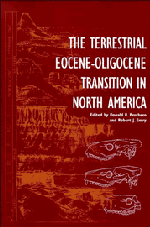Book contents
- Frontmatter
- Contents
- Contributors
- Preface
- PART I The Chronostratigraphy of the Uintan through Arikareean
- PART II Common Vertebrates of the White River Chronofauna
- 16 Testudines
- 17 Squamata
- 18 Ischyromyidae
- 19 Cylindrodontidae
- 20 Castoridae
- 21 Canidae
- 22 Nimravidae
- 23 Amphicyonidae
- 24 Small Arctoid and Feliform Camivorans
- 25 Merycoidodontinae and Miniochoerinae
- 26 Leptaucheniinae
- 27 Leptomerycidae
- 28 Camelidae
- 29 Hyracodontidae
- Summary
- Index
24 - Small Arctoid and Feliform Camivorans
Published online by Cambridge University Press: 06 July 2010
- Frontmatter
- Contents
- Contributors
- Preface
- PART I The Chronostratigraphy of the Uintan through Arikareean
- PART II Common Vertebrates of the White River Chronofauna
- 16 Testudines
- 17 Squamata
- 18 Ischyromyidae
- 19 Cylindrodontidae
- 20 Castoridae
- 21 Canidae
- 22 Nimravidae
- 23 Amphicyonidae
- 24 Small Arctoid and Feliform Camivorans
- 25 Merycoidodontinae and Miniochoerinae
- 26 Leptaucheniinae
- 27 Leptomerycidae
- 28 Camelidae
- 29 Hyracodontidae
- Summary
- Index
Summary
ABSTRACT
The Subparictidae (new family) are an endemic North American radiation of Chadronian (Subparictis) to Arikareean ursoids. The Amphicynodontinae are the earliest known members of the Family Ursidae and first occur in the latest Eocene (middle and late Chadronian) of North America, where they are represented by the middle Chadronian Campylocynodon personi and the late Chadronian? Amphicynodon major. Drassonax harpagops is an Orellan member of this subfamily. The Musteloidea (Mustelavus priscus) and the feliform carnivoran Palaeogale also have their earliest records in North America.
INTRODUCTION
This chapter examines a variety of rare, small, mainly Chadronian and Orellan carnivorans, which occur in rocks of the White River Group or equivalents in North and South Dakota, Wyoming, Nebraska, Colorado, Montana, and Saskatchewan. These include the genera Subparictis, Campy locynodon, Drassonax,? Amphicynodon, Mustelavus, and Palaeogale. The first four are assigned to the Ursoidea, the superfamily containing the extant Ursidae and Pinnipedia. Subparictis is a member of the Subparictidae, a new family which also includes Nothocyon and probably Parictis. Campylocynodon, Drassonax, and? Amphicynodon major are amphicyno-dontines, a subfamily that is much better represented in the Oligocene of Eurasia (Teilhard, 1915; Cirot and de Bonis, 1992). Mustelavus is a very primitive North American member of the Musteloidea, the superfamily which includes the Procyonidae and Mustelidae. The affinities of Palaeogale have not been resolved, but it is probably a primitive feliform. Amphicynodontines, musteloids, and Palaeogale all have a Holarctic distribution in the Oligocene, but their earliest records are in the late Eocene of North America.
- Type
- Chapter
- Information
- The Terrestrial Eocene-Oligocene Transition in North America , pp. 486 - 497Publisher: Cambridge University PressPrint publication year: 1996
- 5
- Cited by



